So you’re looking to purchase a new learning technology.
Congratulations are in order! Caution is too.
Before you hand over the company credit card, it’s wise to take a hard look at exactly where you’re headed. Most likely, you’re entering or about to embark on a procurement or bid process, which typically involves an RFx. (The “R” stands for “request,” The “F” for “for,” and the “x” most often for “proposal,” “quotation,” or “information.”)
If that bid process isn’t handled thoughtfully, it could throw a big wrench into your timeline or even bring your entire project to a screeching halt.

The RFx Process—Challenging but Valuable
Running a bid process before making a big purchase is mandatory at many companies. Having it stand between you and your dream learning solution can be aggravating or even downright demoralizing.
A bid process can be time-consuming. But when it’s done right, it’s also a critical tool—not just an exercise in forbearance. Executed well, it can prevent do-overs and keep your organization from getting stuck with a tool that doesn’t do what it ultimately needs to do—help your people grow to support your organization’s key business objectives.
“Any research process begins with a hypothesis, and buying or procuring new learning tech should be no different,” said Dan Carlson, Degreed Senior Manager for Ecosystem Insights, Marketing, and Communications. Prior to joining Degreed, Dan worked as a technology solutions consultant and manager, writing and reviewing numerous RFxs. “A formal bid process starting with a thorough and systematic RFx is one of the best tools you have to validate your hypothesis and get clear on your needs versus wants, goals, and outcomes—and who will be the best vendor partner to help you succeed.”
How can you make the most of the bid process and make it work for you? Throughout the process, it’s critical to make sure you and your team emphasize what really matters to you and your company. This means thinking about the process as much more than an exercise in checking off a list of product features or compliance points.Let’s explore three key steps you can take to make the bid process for a new learning tech solution work for you and your organization.
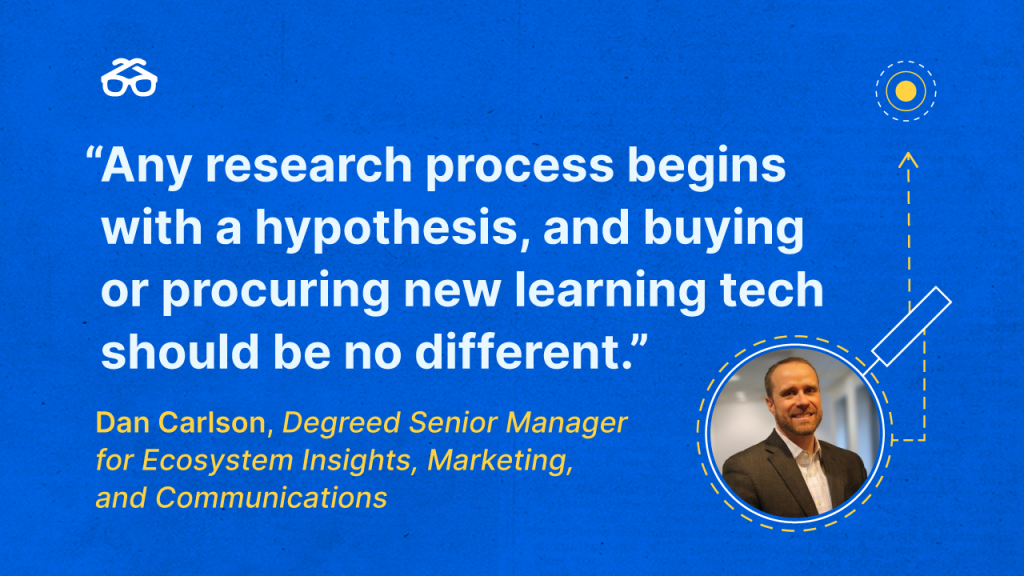
Step No. 1: Get ready.
Unless you’re still exploring the market to find out more about learning technology providers and their offerings, you should be feeling confident by this point that you’ve identified the right group of vendors to approach.
Does this mean your business is ready to buy? Not quite. You’ve still got some prep work to do. But you are closer, and you’re definitely ready to get down to the important details.
Your Business Case
Establishing a solid business case for buying a learning solution—to highlight your objectives and show the value it will bring to your company—is crucial to ensuring all the key stakeholders inside your organization are on board. It’s also critical to helping you find the right solution.
In your business case, describe goals aligned with your company’s objectives and key results (OKRs) as well as specific and unique benefits you anticipate—including existing pain points the solution will solve or efficiencies you expect will be created. The more key performance indicators (KPIs) woven in the better. Later, these KPIs can be incorporated into your bid, as a way for you to uncover how competing vendors would help you and your business achieve success.
The goal here is to obtain buy-in from all internal stakeholders so that, once you’ve evaluated vendors, you can move smoothly into contracting and implementation, free from internal roadblocks.
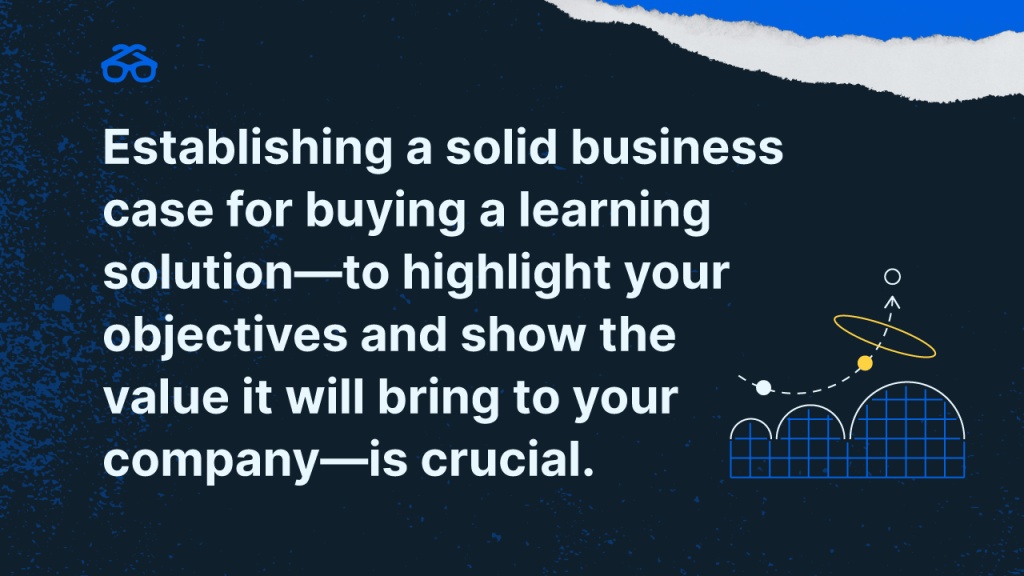
Your Budget
Cost and what you can afford are going to play a huge role in the decisions you ultimately make at the end of the bid process, and there’s no avoiding that.
With your business case in hand, it’s time to secure an approved budget. Going out to bid before your budget is secured—only to find out your business case isn’t as strong as you thought, or that some key internal decision-makers are blocking the project—can be extremely frustrating and counterproductive. As a vendor, we see it all the time: After hundreds of hours of working with us, prospective clients discover they don’t have the budget to buy.
When budgeting, ask vendors for estimated licensing costs. These can help you establish how much money you might need. Along the way, involve all major internal stakeholder groups like IT, HR, and the C-suite.
Your Objectives, Weighted
Review your business case objectives and think about which matters most. Get granular and rank features (for example, assessment capabilities or a built-in skills taxonomy), requirements (such as data hosting locations or integration methods), and services (like implementation assistance or customer service). These are your “business-critical requirements. Certainly also consider org-wide compliance requirements that are bigger than your individual project (perhaps sustainability goals or contractual requirements).
Once you’ve created your weighted list, put it aside and keep it close by. You can use it as a pass-fail criteria once you start writing your RFx.
You’re going to hear a lot of vendors try to sell you things you frankly didn’t want or need before the bid process began. Avoid the pitfall of comparing features head-to-head and focus more on determining which elements of a solution will actually make your project successful in the eyes of your end users and to your business. Hot tip: Your weighted list can also help you measure the success of the technology after it’s been implemented.
To help you find the right solution provider, we’ve collected a series of questions you can ask during the learning tech vendor selection process. Use these to hone your efforts and strategy:
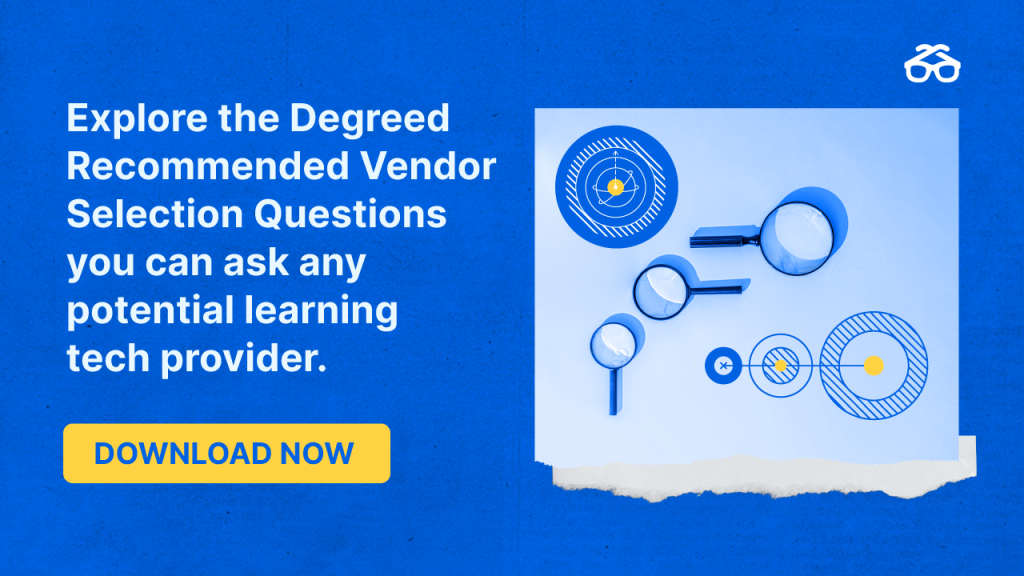
Step No. 2: Write your RFx.
Let’s write! Once you’ve worked through the steps above, you’ll likely be wondering how to put them into practice and actually draft the darn thing. There are several components to consider related to formats and deliverables, levels of engagement, and RFx content. Let’s unpack them.
Project Description and Instructions
Create a standalone document that clearly describes your company, project, and goals. This is often referred to as a project scope, and it should include a list of RFx deliverables and any instructions or constraints you’d like to see as well as specified formats, word count limits, crosswalk instructions, and optionally your weighting and evaluation criteria.
This document is read-only for the vendor, and it can be created with the tool of your choice.
Specific Product Questions
For a learning technology purchase, most of our prospective clients provide a spreadsheet with questions that are easily answered with yes, no, or a brief comment. The spreadsheet is sometimes organized into tabs (for example, functional versus non-functional questions) or sections (including prompts like the Degreed Recommended Vendor Selection Questions).
You might include several answer formats (such as yes or no, multiple choice, or free-text field) and also ask vendors to provide additional information on key topics in a separate document, which can make it easy to organize and provide long-form answers, images, and diagrams.
Levels of Engagement
The levels of engagement you seek from vendors will depend on whether you’re working with an RFI (request for information), RFP (request for a proposal), or an RFQ (request for a quotation). For example, it’s probably not necessary to ask vendors to redline your standard contractual agreement at an RFI stage because the goal is to simply narrow down a long list of vendors to a shorter, more manageable list to be used later during the RFP stage.
Include any compliance-related items that are deal breakers for your organization. If you have strict information security or data privacy policies, providing them early can help to quickly narrow the field. It’s best to include these sooner rather than later to avoid the disappointment of advancing with a great vendor that you ultimately cannot work with. And if you have any contracting constraints, now is also a good time to make sure vendors understand them and can comply—again, to avoid the frustration of choosing a vendor only to find out you can’t sign on the dotted line.
Content
Once your formats are identified and you know the deliverables you need to carry out your evaluation process, it’s time to start creating templates for vendors and adding your questions and requirements to them.
Avoid asking vendors for a “kitchen sink” wishlist and focus instead on information specific to the learning technology you’re looking to purchase. Vendors can easily get confused by an abjectly written RFx describing a hodgepodge of technologies or platforms.
Ask simple questions. Keep things streamlined. Formulate questions so they’re easy to understand and respond to and, most importantly, get you the information you need.
Don’t ask broad questions like this:
What is your integration strategy?
Instead, ask narrow questions like these:
Do you operate with an open ecosystem?
How do you integrate with existing technologies?
How is content added to your platform?
Broad questions lead to answers that are wildly different from one vendor to the next, making it difficult to compare their solutions. Narrow questions organized into subtopics, on the other hand, facilitate comparison.
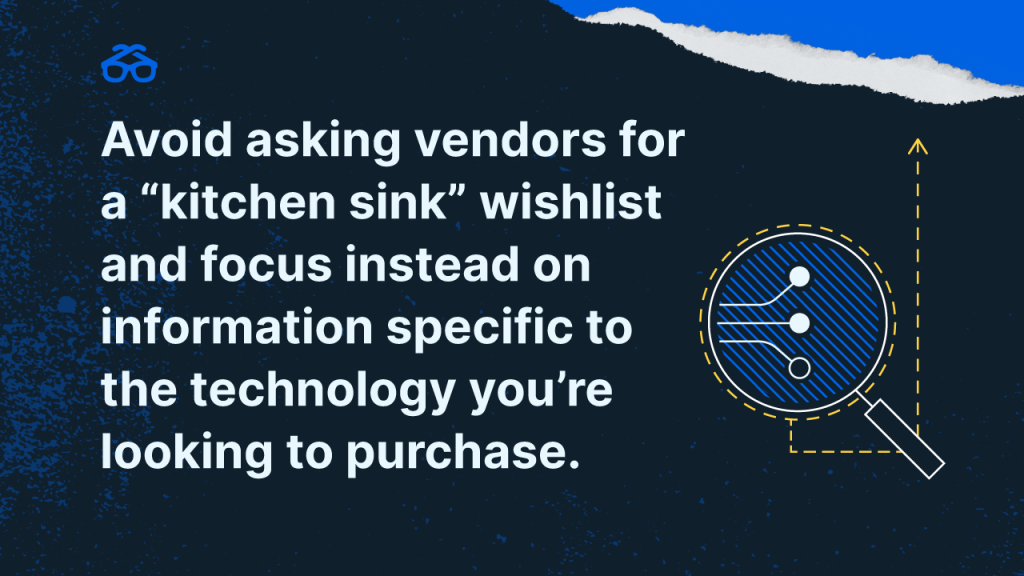
Step No. 3: Evaluate vendors.
To begin evaluating vendors, first score their answers based on your weighting and evaluation criteria. You might quickly find that features and functionality rank similarly from vendor to vendor, leading to similar scores.
When that happens, what can you look to to really tip the balance? Often, it’s how competing vendors handle your business-critical requirements.
Compliance and Alignment as Differentiators
Remember those must-have, business-critical requirements you identified in Step No. 1? You included them on your weighted list and kept it close by, and now it’s time to pull it back out. Run down your list and eliminate vendors that don’t meet your compliance requirements for contracting, information security, or other key pass-fail considerations.
Once you’ve gone through this exercise, you can focus on which learning solutions are most aligned with what matters most—your business needs and project goals. Spend time on those items that you weighted the highest in Step No. 1, whether they fall into the category of features, requirements, or services.
Critiquing with Focus
Rank the questions and answers from vendors that remain in your pool in order of importance. As you do, stay committed to your goals and objectives and your weighted criteria from Step No. 1. This is especially important in the wake of unexpected, attention-grabbing proposals that can tempt you off track. Indeed, “bells and whistles” are the hallmarks of distraction.
Can you learn more during a competitive bid process than you would have if you hadn’t gone out to bid? Yes. Does that mean that you need to solve a different problem than the one you set out to? No, it does not.
Scoring Vendors
Let’s take a closer look at how you can methodically score vendors’ responses using your weighted criteria.
One scoring method is to assign numbers to vendor responses (for example, some might receive a 7 or 8 while another gets a perfect 10).
Another way to score responses is to look at each and ask, “How important is this?” With that question in mind, you can place each response into one of the following categories:
Not That Relevant
The vendor’s response really doesn’t mean much in the grand scheme of your problem solving. Even if it seems cool, it rates low.
Okay
The vendor’s response represents a good-to-have, but it’s not a necessity for achieving project goals.
Better Than What We Have Now
The vendor’s response meets or maybe even exceeds your expectations.
Very Helpful
The vendor’s response is where it’s at. This is what you’ve been looking for, because it solves your original problem and addresses your business needs.
Gut Checks & Final Considerations
If you requested some sort of supporting proposal along with the answers to your specific questions, now’s the time to review that information. This is another area where you can differentiate vendors with similar scores.
Read the executive summary. How does it make you feel? Does the vendor understand what you’re trying to achieve? Has the vendor shown how its solution can help? Has the vendor demonstrated how and why it has the right team to help you accomplish your goals?
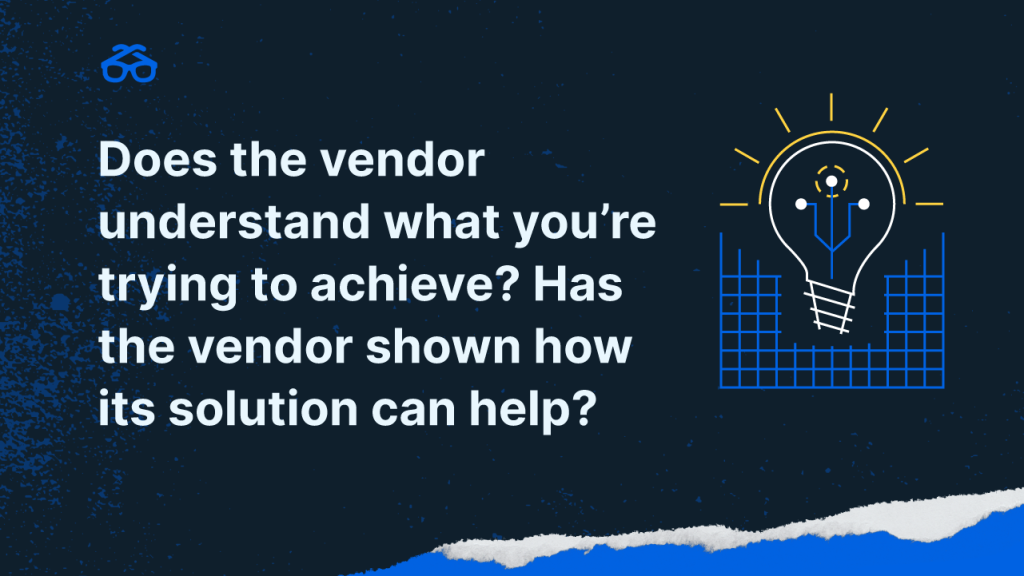
In Conclusion
Some companies don’t have lofty learning goals. Often, they just want some software to serve up content to employees as a “perk.” Others are looking beyond content to skills and learning data. Wherever you fall on the spectrum, clearly defining your goals and running a bid process can help you achieve outcomes that advance your organization.
At Degreed, we believe that finding a vendor is about more than you simply sourcing software or landing on a technology with the right components. It’s about you finding a partner. It’s about you feeling heard. It’s about you being understood and supported—and this should all begin at hello, long before any contract is signed.
Kelsy Meyer is a Senior Global Proposal Specialist at Degreed focused on strategic bid management.
